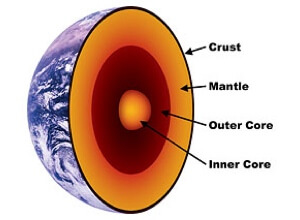
It’s an expensive journey – costing a billion dollars – and it’s wrought with hazards that could derail the explorers at any moment. But if these explorers reach their destination, they will have gone where no one has gone before. And, in doing so, they will uncover new knowledge about our domain and about ourselves. No, these explorers aren’t setting out to explore the deeps of space, but the deep beneath the Earth’s surface.
The group of geologists involved in the Integrated Ocean Drilling Program (IODP) aim to penetrate 6 kilometers through the Earth’s crust and reach our planet’s second layer, the mantle. From the mantle they hope to retrieve samples which will answer some basic questions about geology, climate change, and life here on Earth.
The mantle makes up about two-thirds of the Earth’s total mass. Just below the Earth’s crust, the upmost level that form the rocks, mountains, and continents that we know, the Earth’s perpetual stirring of the mantle is what drives volcanic activity, causes earthquakes, moves tectonic plates and shapes the hard outer face of the Earth across geological ages. Right now, geologists are pretty much limited to this sort of broad snapshot of what goes on beneath. Essentially what they do know has come indirectly from mantle-derived rocks and computer simulations. Detailed knowledge of mantle processes are sorely lacking. The IODP team is attempting to remedy that with, what one researcher calls, “the most challenging endeavor in the history of Earth science.”
They plan to break through where the Earth’s crust is thinnest. The actually drilling site is yet to be decided upon, but the three locations in the middle of the Pacific being considered are all about 6 km (3.73 miles) thick. Still a massive amount of rock to get through, but certainly much more preferable to drilling through crust over land which can be up to 60 km thick.
The drills themselves are enormous, each about 10 km (6.2 miles) in length. But that’s what is required to reach down through 2 km (1.2 miles) of sea water and penetrate the 6 km of crust. And once down there, the drills have their work cut out for them. The rock is hard enough that the lifetime of each drill will last only 50 to 60 hours. Because they’ll have to change the drills so often, it will take years before they actually reach the mantle.

Much of the deep-drilling technologies needed for the project are already being used by the oil and gas industry. And not only will the great depth be a challenge, but the extremely narrow size of the hole – just 30 cm (11 in) wide. Damon Teagle, a co-leader of the project from the UK’s University of Southampton, told CNN, “It will be the equivalent of dangling a steel string the width of a human hair in the deep end of a swimming pool and inserting it into a thimble 1/10 mm wide on the bottom, and then drilling a few meters into the foundation.”
Like the moon missions, reaching the mantle will require technology at the very edge of our capabilities. That’s why the team has enlisted the help of the best equipped drilling ship on the planet. The Japanese vessel, Chikyu, is both a research vessel and the world record holder for drilling depth. On Sept. 9 its drills reached a depth of 2,466 m below seafloor, penetrating a buried coal formation from which it returned samples. Chikyu is Japan’s contribution to the mantle mission, which some people are enthusiastically calling the country’s “moon project.” If the team can get more funding, Teagle says, they could begin drilling before the end of the decade and reach the mantle by the early 2020s.
The drilling project could lead to the placement of underground sensors that could serve as an observatory for geologists, providing realtime data on everything from plate tectonics, volcanic eruptions and earthquakes. Like the oceanographers who are now placing remote sensing observatories on the ocean floor, the drilling project is another show of humanity’s increasing mastery of the planet.
Despite the fact that we know more about the surface of Mars than we do about our planet’s second layer, some are questioning the wisdom of the project, especially its $1 billion price tag. The geologists, however, attest that samples from the mantle will provide a detailed record of the Earth’s climate and environmental history. By better knowing what changes occurred in the past, they argue, we’ll be able to better model those changes in the future and also improve our ability to assess how they’re impacted by human behavior.
The geologists are also excited about the life forms they may find buried deep in the Earth’s crust. Ocean drilling in the past has already uncovered microbial life a kilometer beneath the seabed, and they expect there to be a lot more deeper below. Studying these previously unknown species could lead to new insights into evolution – specifically what kinds of adaptations lead to the sustainability of life under such extreme conditions.
Lastly, Teagle hopes that the program will do for the Earth what the Apollo missions did for the moon and space. He hopes that the downward journey will inspire young people to be curious about their planet and to explore that unchartered world right beneath their feet.
[image credits: CNN and PITSCO Education Online]
images: CNN and PITSCO Education Online



